Mitigation of Non-CO2 Aviation’s Climate Impact by Changing Cruise Altitudes
Abstract
1. Introduction
2. Materials and Methods
2.1. Modelling Concept for Climate Impact Assessment
2.2. Emission Inventories for Flying Lower and Flying Higher
2.3. Atmospheric Modelling of Aviation-Induced Non-CO2 Impacts
2.4. Calculation of Non-CO2 Radiative Impacts
3. Changes in Atmospheric Composition and Radiative and Temperature Responses
3.1. Effect of Aviation Nitrogen Oxides
3.2. Contrail and Contrail Cirrus Effect
3.3. Aerosol-Indirect Effect on Warm Clouds (AiwC)
3.4. Overview of Climate Impact of Non-CO2 Effects of Aviation
3.5. Assessing Climate Impact of Alternative Routing Concepts in Aviation
3.6. Overview of the Climate Impact of Non-CO2 Effects of Aviation
4. Discussion
5. Conclusions and Outlook
Author Contributions
Funding
Institutional Review Board Statement
Informed Consent Statement
Data Availability Statement
Acknowledgments
Conflicts of Interest
Abbreviations
| aCCF | Algorithmic Climate Change functions |
| AiwC | Aerosol indirect effect on warm clouds |
| CTM | Chemistry Transport Model |
| GCM | General Circulation Model |
| AIC | Aviation induced cloudiness |
| ATR | Average Temperature Response |
| ERF | Effective Radiative Forcing |
| RF | Radiative forcing |
Appendix A
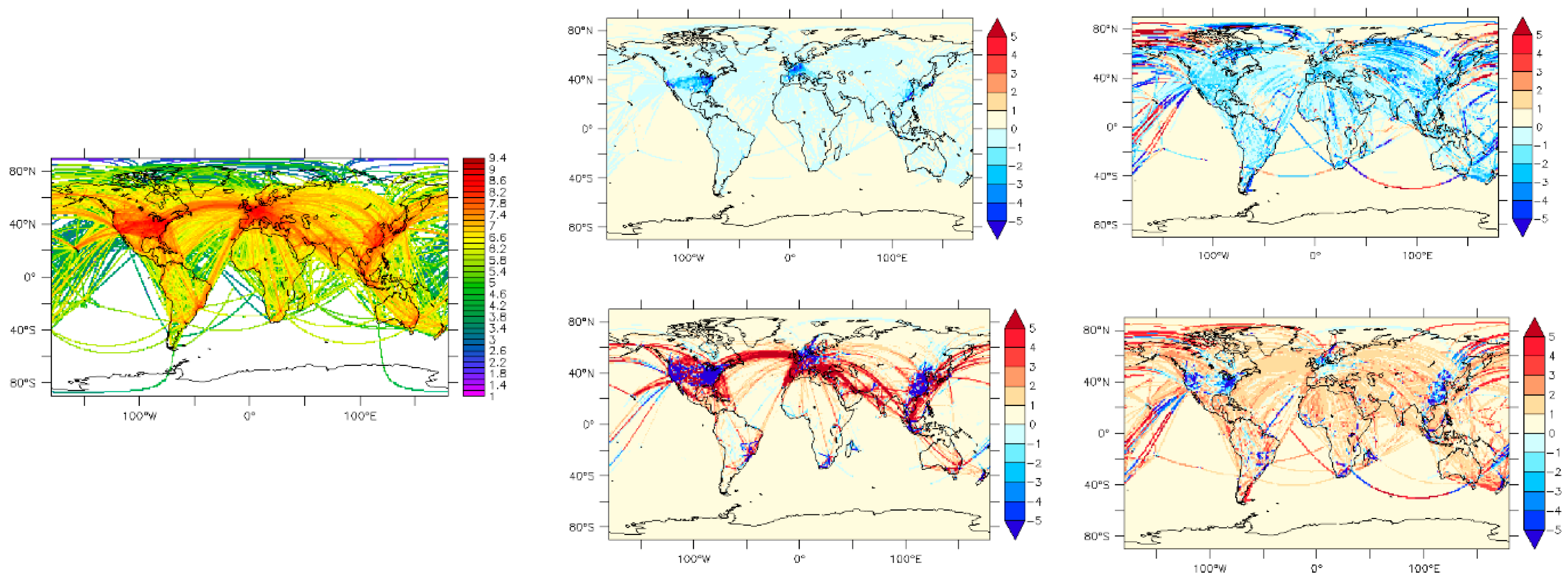
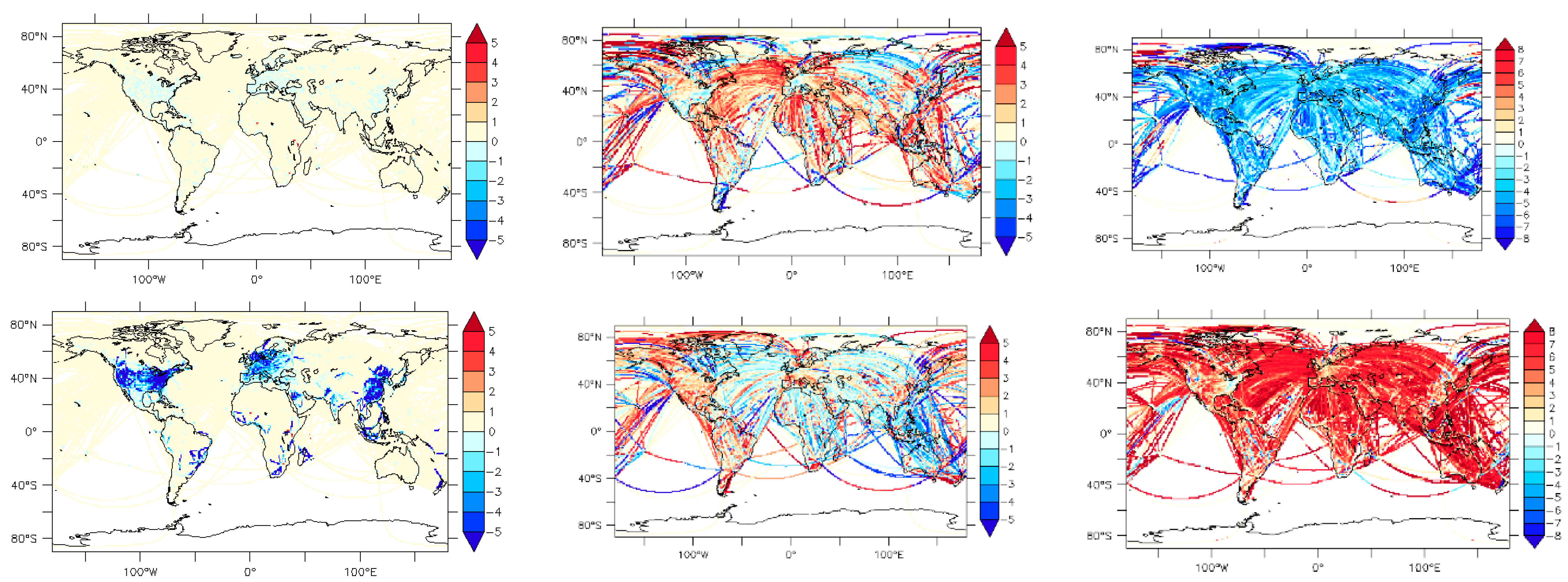
Appendix B
| Impact | REACT4C | CH4 Update | Sensitivity | |||||||
|---|---|---|---|---|---|---|---|---|---|---|
| Attribution | Perturbation | Perturbation | Tagging 1 | |||||||
| Inventory | Ref | Low | High | Ref | Low | High | Ref | Low | High | |
| NOx-Ozone | 19.5 | 18.2 | 21.1 | 19.5 | 18.2 | 21.1 | 30.6 | 28.5 | 33.1 | Tagging 1 |
| NOx-Methane | −8.7 | −8.9 | −8.6 | −7.0 | −7.1 | −6.9 | −7.0 | −7.1 | −6.9 | Rad 2, lifetime 3 |
| NOx-PMO | −4.3 | −4.4 | −4.3 | −2.8 | −2.9 | −2.8 | −2.8 | −2.9 | −2.8 | Lifetime 3 |
| NOx-H2O | −1.3 | −1.3 | −1.3 | −0.8 | −0.8 | −0.8 | −0.8 | −0.8 | −0.8 | Lifetime 3 |
| Net NOx | 5.2 | 3.5 | 6.9 | 8.9 | 7.3 | 10.6 | 20.0 | 17.6 | 22.6 | |
| Altitude effect | −1.8 | 1.8 | −1.6 | 1.7 | −2.4 | 2.6 | ||||
References
- Dameris, M.; Grewe, V.; Köhler, I.; Sausen, R.; Brühl, C.; Grooß, J.-U.; Steil, B. Impact of aircraft NOx emissions on tropospheric and stratospheric ozone. Part II: 3-D model results. Atmos. Environ. 1998, 32, 3185–3199. [Google Scholar] [CrossRef]
- Grewe, V.; Dameris, M.; Fichter, C.; Lee, D.S. Impact of aircraft NOx emissions. Part 2: Effects of lowering the flight altitude. Meteorol. Z. 2002, 11, 197–205. [Google Scholar] [CrossRef]
- Köhler, M.O.; Rogers, H.L.; Pyle, J.A. Modelling the Impact of Subsonic Aircraft Emissions on Ozone: Future Changes and the Impact of Cruise Altitude Perturbations. In Proceedings of the European Conference on Aviation, Atmosphere and Climate (AAC), Friedrichshafen, Germany, 30 June–3 July 2003. [Google Scholar]
- Fichter, C.; Marquart, S.; Sausen, R.; Lee, D.S. The impact of cruise altitude on contrails and related radiative forcing. Meteorol. Z. 2005, 14, 563–572. [Google Scholar] [CrossRef]
- Gauss, M.; Isaksen IS, A.; Lee, D.S.; Søvde, O.A. Impact of aircraft NOx emissions on the atmosphere—Tradeoffs to reduce the impact. Atmos. Chem. Phys. 2006, 6, 1529–1548. [Google Scholar] [CrossRef]
- Rädel, G.; Shine, K.P. Radiative forcing by persistent contrails and its dependence on cruise altitudes. J. Geophys. Res. 2008, 113, D07105. [Google Scholar] [CrossRef]
- Frömming, C.; Ponater, M.; Dahlmann, K.; Grewe, V.; Lee, D.S.; Sausen, R. Aviation-induced radiative forcing and surface temperature change in dependency of the emission altitude. J. Geophys. Res. 2012, 117, D19104. [Google Scholar] [CrossRef]
- Skowron, A.; Lee, D.S.; De León, R.R. The assessment of the impact of aviation NOx on ozone and other radiative forcing responses—The importance of representing cruise altitudes accurately. Atmos. Environ. 2013, 74, 159–168. [Google Scholar] [CrossRef]
- Matthes, S.; Schumann, U.; Grewe, V.; Frömming, C.; Dahlmann, K.; Koch, A.; Mannstein, H. Climate optimized air transport. In Atmospheric Physics, Research Topics in Aerospace; Schumann, U., Ed.; Springer: Berlin/Heidelberg, Germany, 2012; pp. 727–746. [Google Scholar] [CrossRef]
- Matthes, S.; Grewe, V.; Sausen, R.; Roelofs, G.-J. Global impact of road traffic emissions on tropospheric ozone. Atmos Chem. Phys. 2007, 7, 1707–1718. [Google Scholar] [CrossRef]
- Bier, A.; Burkhardt, U. Variability in contrail ice nucleation and its dependence on soot number emissions. J. Geophys. Res. Atmos. 2019, 124, 3384–3400. [Google Scholar] [CrossRef]
- Burkhardt, U.; Karcher, B.; Mannstein, H.; Schumann, U. Climate Impact of Contrails and Contrail Cirrus Research Paper, SSWP No. 6. 2008. Available online: https://rosap.ntl.bts.gov/view/dot/17379 (accessed on 28 January 2021).
- Grewe, V.; Champougny, T.; Matthes, S.; Frömming, C.; Brinkop, S.; Søvde, O.A.; Irvine, E.A.; Halscheidt, L. Reduction of the air traffic’s contribution to climate change: A REACT4C case study. Atmos. Environ. 2014, 94, 616–625. [Google Scholar] [CrossRef]
- Søvde, O.; Matthes, S.; Skowron, A.; Iachetti, D.; Lim, L.; Owen, B.; Hodnebrog, T.; Di Genova, G.; Pitari, G.; Lee, D. Aircraft emission mitigation by changing route altitude: A multi-model estimate of aircraft NOx emission impact on O3 photochemistry. Atmos. Environ. 2014, 95, 468–479. [Google Scholar] [CrossRef]
- Lim, L.L.; Lee, D.S.; Owen, B.; Skowron, A.; Matthes, S.; Burkhardt, U.; Dietmüller, S.; Pitari, G.; Di Genova, G.; Iachetti, D.; et al. REACT4C: Simplified mitigation studies. In Proceedings of the TAC-4 Conference, Bad Kohlgrub, Germany, 22–25 June 2015. [Google Scholar]
- Grewe, V.; Dahlmann, K.; Matthes, S. The contribution of aviation NOx emissions to climate change: Are we ignoring methodological flaws. Environ. Res. Lett. 2019, 14, 121003. [Google Scholar] [CrossRef]
- Lee, D.; Pitari, G.; Grewe, V.; Gierens, K.; Penner, J.; Petzold, A.; Prather, M.; Schumann, U.; Bais, A.; Berntsen, T.; et al. Transport impacts on atmosphere and climate: Aviation. Atmos. Environ. 2010, 44, 4678–4734. [Google Scholar] [CrossRef] [PubMed]
- Lee, D.S.; Fahey, D.W.; Skowron, A.; Allen, M.R.; Burkhardt, U.; Chen, Q.; Doherty, S.J.; Freeman, S.; Forster, P.M.; Fuglestvedt, J.; et al. The contribution of global aviation to anthropogenic climate forcing for 2000 to 2018. Atmos. Environ. 2021, 244, 117834. [Google Scholar] [CrossRef]
- Matthes, S. Climate-optimised flight planning—REACT4C. In Innovation for a Sustainable Aviation in a Global Environment, Proceedings of the Sixth European Aeronautics Days 2011, Madrid, Spain, 30 March – 1 April 2011; IOS Press &: Amsterdam, The Netherlands; European Union: Brussels, Belgium, 2012; ISBN 978-92-79-22968-8. [Google Scholar]
- Owen, B.; Lim, L.L.; Gray, E.; Lee, D.S. Emission Inventories for Sensitivity Studies; CATE, Manchester Metropolitan University: Manchester, UK, 2011. [Google Scholar]
- Pitari, G.; Cionni, I.; Di Genova, G.; Søvde, O.A.; Lim, L. Radiative forcing from aircraft emissions of NOx: Model calculations with CH4 surface flux boundary condition. Meteorol. Z. 2016. [Google Scholar] [CrossRef]
- Zhu, J.; Penner, J.E. Radiative forcing of anthropogenic aerosols on cirrus clouds using a hybrid ice nucleation scheme. Atmos. Chem. Phys. 2020, 20, 7801–7827. [Google Scholar] [CrossRef]
- Bock, L.; Burkhardt, U. Contrail cirrus radiative forcing for future air traffic. Atmos. Chem. Phys. 2019, 19, 8163–8174. [Google Scholar] [CrossRef]
- Jöckel, P.; Tost, H.; Pozzer, A.; Brühl, C.; Buchholz, J.; Ganzeveld, L.; Hoor, P.; Kerkweg, A.; Lawrence, M.; Sander, R.; et al. The atmospheric chemistry general circulation model ECHAM5/MESSy1: Consistent simulation of ozone from the surface to the mesosphere. Atmos. Chem. Phys. 2006, 6, 5067–5104. [Google Scholar] [CrossRef]
- Jöckel, P.; Tost, H.; Pozzer, A.; Kunze, M.; Kirner, O.; Brenninkmeijer, C.A.M.; Brinkop, S.; Cai, D.S.; Dyroff, C.; Eckstein, J.; et al. Earth System Chemistry Integrated Modelling (ESCiMo) with the Modular Earth Submodel System (MESSy, version 2.51). Geosci. Model Dev. 2016, 9, 1153–1200. [Google Scholar] [CrossRef]
- Righi, M.; Hendricks, J.; Sausen, R. The global impact of the transport sectors on atmospheric aerosol: Simulations for year 2000 emissions. Atmos. Chem. Phys. 2013, 13, 9939–9970. [Google Scholar] [CrossRef]
- Burkhardt, U.; Kärcher, B. Process-based simulation of contrail cirrus in a global climate model. J. Geophys. Res. 2009, 114, D16201. [Google Scholar] [CrossRef]
- Schumann, U. On conditions for contrail formation from aircraft exhausts. Meteorol. Z. 1996, 5, 4–23. [Google Scholar] [CrossRef]
- Burkhardt, U.; Kärcher, B.; Ponater, M.; Gierens, K.; Gettelman, A. Contrail cirrus supporting areas in model and observations. Geophys. Res. Lett. 2008, 35, L16808. [Google Scholar] [CrossRef]
- Lamquin, N.; Stubenrauch, C.; Gierens, K.; Burkhardt, U.; Smit, H. A global climatology of upper-tropospheric ice supersaturation occurence inferred from the Atmospheric Infrared Sounder calibrated by MOZAIC. Atmos. Chem. Phys. 2012, 12, 381–405. [Google Scholar] [CrossRef]
- Kärcher, B.; Burkhardt, U.; Bier, A.; Bock, L.; Ford, I.J. The microphysical pathway to contrail formation. J. Geophys. Res. Atmos. 2015, 120, 7893–7927. [Google Scholar] [CrossRef]
- Burkhardt, U.; Kärcher, B. Global radiative forcing from contrail cirrus. Nat. Clim. Chang. 2011, 1, 54–58. [Google Scholar] [CrossRef]
- Bock, L.; Burkhardt, U. Reassessing properties and radiative forcing of contrail cirrus using a climate model. J. Geophys. Res. 2016, 121, D9717–D9736. [Google Scholar] [CrossRef]
- Burkhardt, U.; Bock, L.; Bier, A. Mitigating the contrail cirrus climate impact by reducing aircraft soot number emissions. NPJ Clim. Atmos. Sci. 2018, 37, 1–7. [Google Scholar] [CrossRef]
- Myhre, G.; Kvalevåg, M.; Rädel, G.; Cook, J.; Shine, K.P.; Clark, H.; Karcher, F.; Markowicz, K.; Kardas, A.; Wolkenberg, P.; et al. Intercomparison of radiative forcing calculations of stratospheric water vapour and contrails. Meteorol. Z. 2009, 18, 585–596. [Google Scholar] [CrossRef]
- Schumann, U.; Penner, J.E.; Chen, Y.; Zhou, C.; Graf, K. Dehydration effects from contrails in a coupled contrail-climate model. Atmos. Chem. Phys. 2015, 15, 11179–11199. [Google Scholar] [CrossRef]
- Bickel, M.; Ponater, M.; Bock, L.; Burkhardt, U.; Reineke, S. Estimating the Effective Radiative Forcing of Contrail Cirrus. J. Clim. 2020, 33, 1991–2005. [Google Scholar] [CrossRef]
- Righi, M.; Hendricks, J.; Sausen, R. The global impact of the transport sectors on atmospheric aerosol in 2030—Part 2: Aviation. Atmos. Chem. Phys. 2016, 16, 4481–4495. [Google Scholar] [CrossRef]
- Lamarque, J.-F.; Bond, T.C.; Eyring, V.; Granier, C.; Heil, A.; Klimont, Z.; Lee, D.S.; Liousse, C.; Mieville, A.; Owen, B.; et al. Historical (1850–2000) gridded anthropogenic and biomass burning emissions of reactive gases and aerosols: Methodology and application. Atmos. Chem. Phys. 2010, 10, 7017–7039. [Google Scholar] [CrossRef]
- Grewe, V.; Stenke, A. AirClim: An efficient climate impact assessment tool. Atmos. Chem. Phys. 2008, 8, 4621–4639. [Google Scholar] [CrossRef]
- Dahlmann, K.; Grewe, V.; Frömming, C.; Burkhardt, U. Can we reliably assess climate mitigation options for air traffic scenarios despite large uncertainties in atmospheric processes? Transp. Res. Part D Transp. Environ. 2016, 46, 40–55. [Google Scholar] [CrossRef]
- Dahlmann, K.; Grewe, V.; Ponater, M.; Matthes, S. Quantifying the contributions of individual NOx sources to the trend in ozone radiative forcing. Atmos. Environ. 2011, 45, 2860–2868. [Google Scholar] [CrossRef]
- Hendricks, J.; Kärcher, B.; Lohmann, U.; Ponater, M. Do aircraft black carbon emissions affect cirrus clouds on the global scale? Geophys. Res. Lett. 2005, 32. [Google Scholar] [CrossRef]
- Hendricks, J.; Kärcher, B.; Lohmann, U. Effects of ice nuclei on cirrus clouds in a global climate model. J. Geophys. Res. 2011, 116, 1–24. [Google Scholar] [CrossRef]
- Tesche, M.; Achtert, P.; Glantz, P.; Noone, K.J. Aviation effects on already-existing cirrus clouds. Nat. Commun. 2016, 7, 12016. [Google Scholar] [CrossRef]
- Holmes, C.D.; Tang, Q.; Prather, M.J. Uncertainties in climate assessment for the case of aviation NO. Proc. Natl. Acad. Sci. USA 2011, 108, 10997–11002. [Google Scholar] [CrossRef]
- Matthes, S.; Lührs, B.; Dahlmann, K.; Grewe, V.; Linke, F.; Yin, F.; Klingaman, E.; Shine, K.P. Climate-Optimized Trajectories and Robust Mitigation Potential: Flying ATM4E. Aerospace 2020, 7, 156. [Google Scholar] [CrossRef]
- Matthes, S.; Ling, L.; Burkhardt, U.; Dahmann, K.; Dietmüller, S.; Grewe, V.; Haslerud, A.S.; Hendricks, J.; Lee, D.S.; Owen, B.; et al. Mitigation of aviation’s non-CO2 climate impact by changing cruise altitudes. In Proceedings of the Making Aviation Environmentally Sustainable, ECATS 3rd Conference, online, 13–15 October 2020; ECATS IASBL. pp. 83–89, ISBN 978-1-910029-58-9. [Google Scholar]
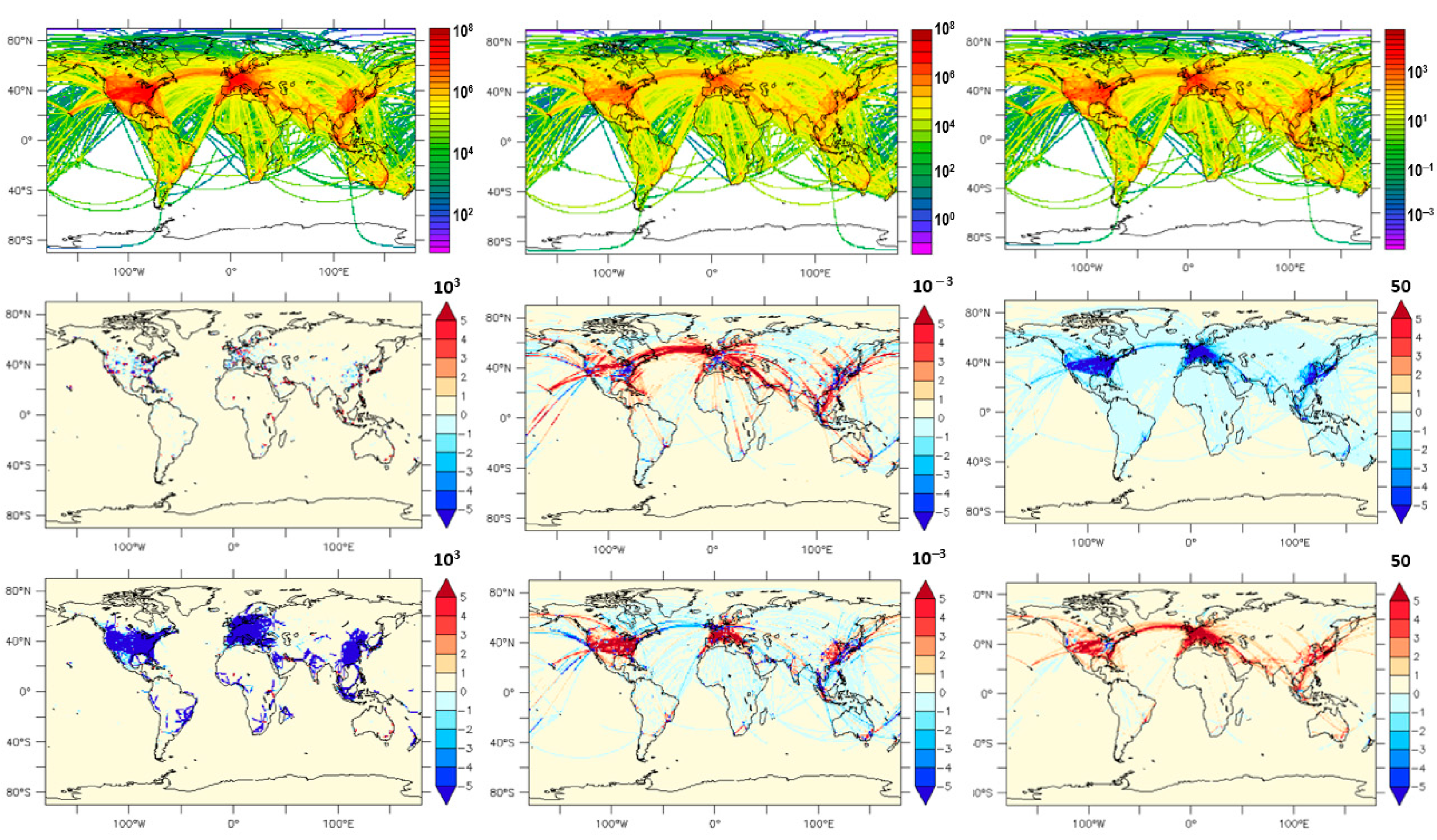

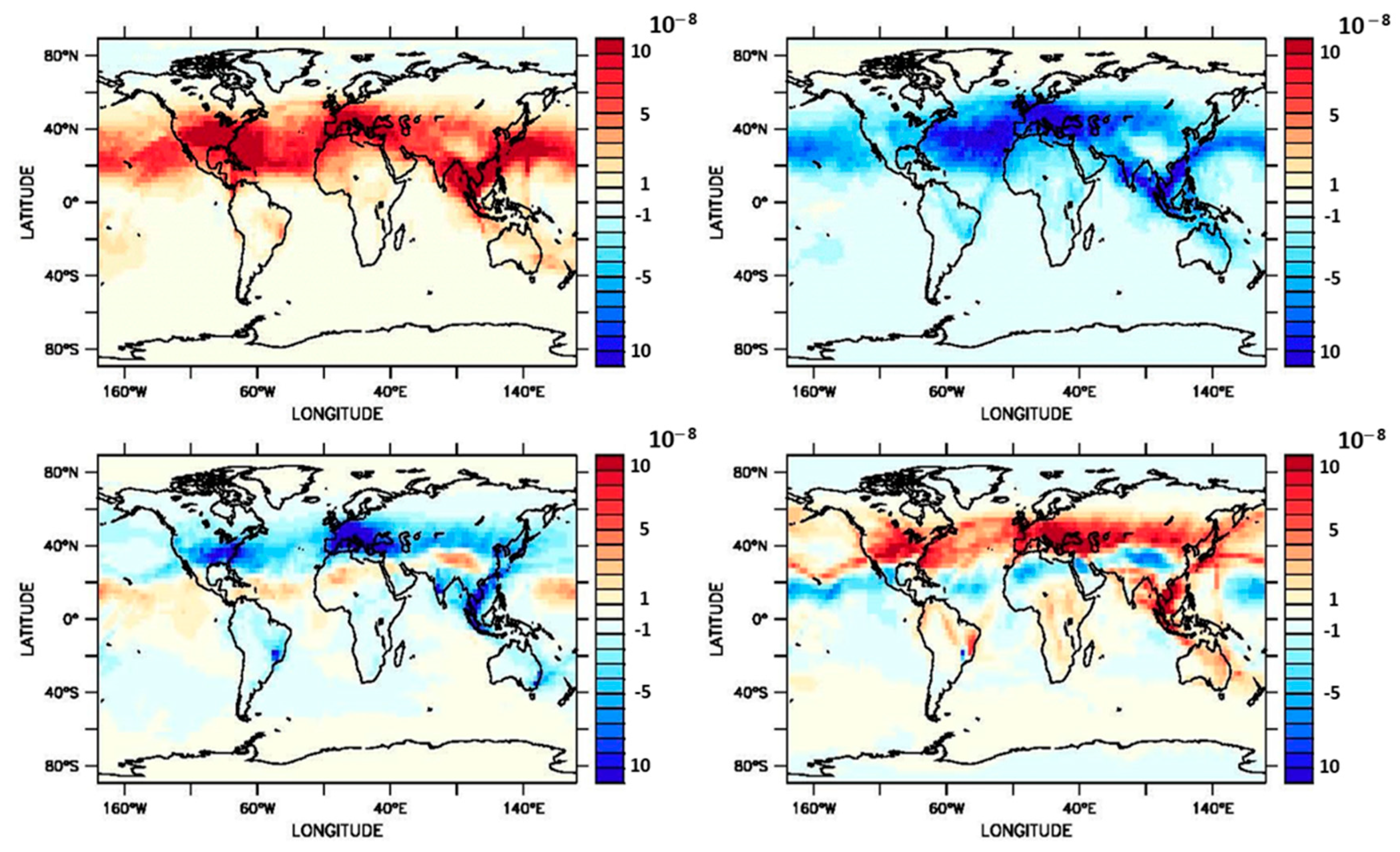
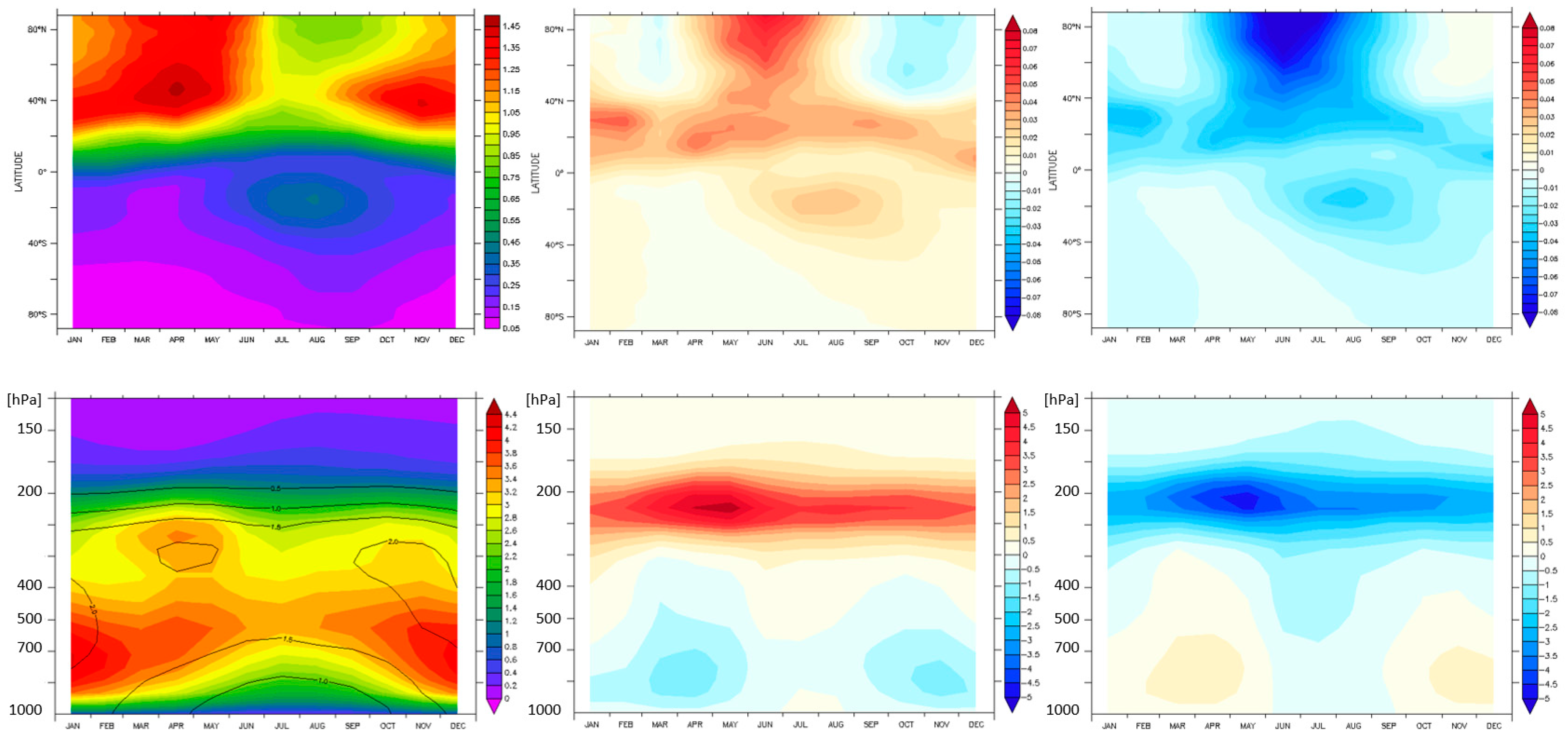



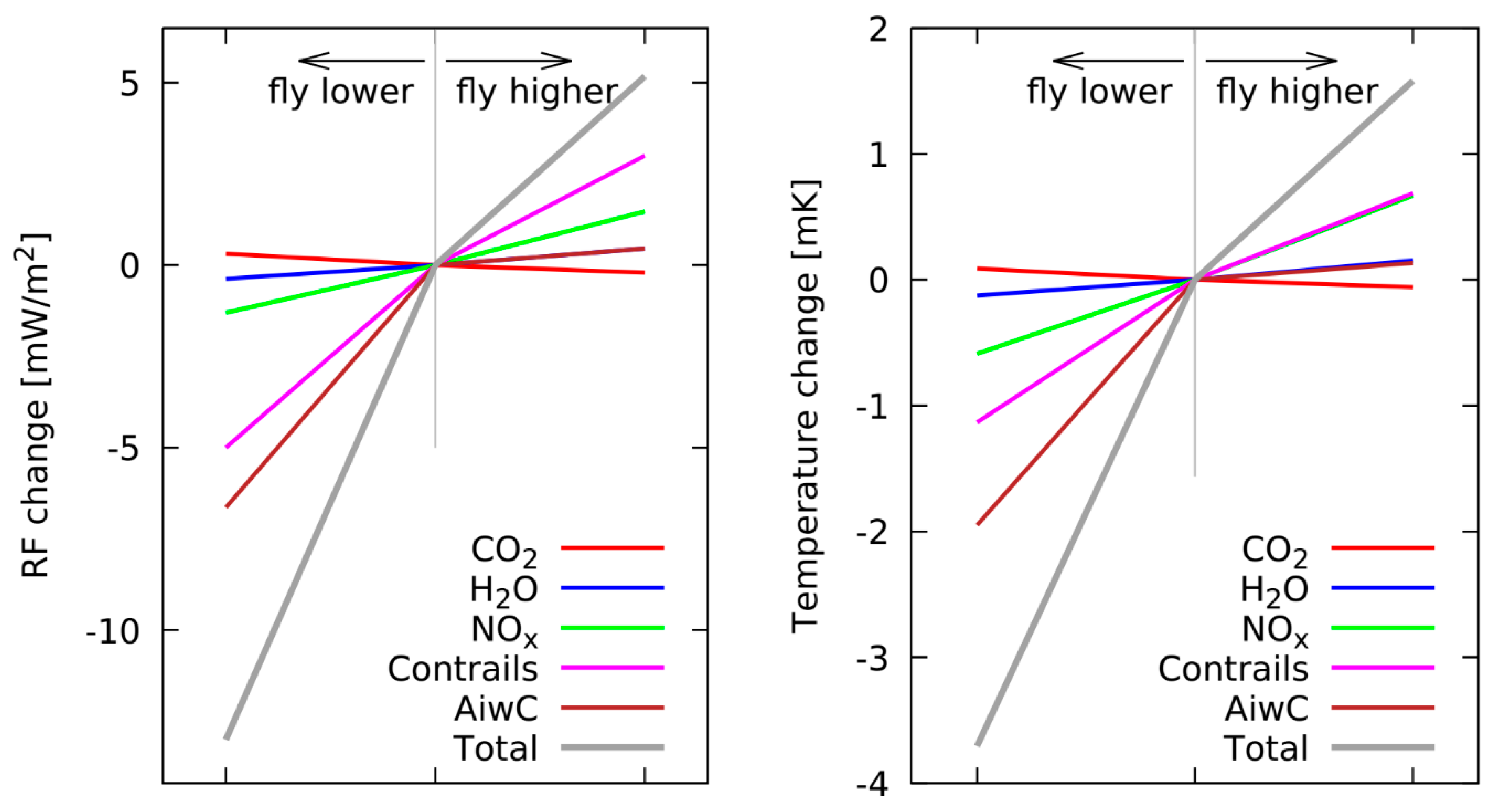
| Scenario | Fuel | CO2 | NOx | Soot |
|---|---|---|---|---|
| [Tg] | [Tg] | [Tg NO2] | [Tg] | |
| Base case (reference) | 178.3 | 563.4 | 2.338 | 0.00407 |
| Flying Lower | 180.7 | 571.0 | 2.339 | 0.00432 |
| Flying Higher | 176.8 | 558.7 | 2.358 | 0.00388 |
| Model | Type 1 | Setup 2 | Resolution | Length [a] | Rad. | Effects | Reference |
|---|---|---|---|---|---|---|---|
| ECHAM4-CCMod | GCM | FR | T30/L39 | 10 | online | CC | [27] |
| EMAC/MESSy | QCTM | SD | T42/L90 | 4 | offline | NOx | [25] |
| EMAC/MADE3 | GCM | SD | T42/L19 | 15 | online | AiwC | [26] |
| MOZART-3 | CTM | SD | T42/L60 | 4 | offline | NOx | [8] |
| Oslo CTM3 | CTM | SD | T42/L90 | 4 | offline | NOx | [14] |
| ULAQ | GCM | SD | T21/L126 | 10 | offline | NOx | [21] |
| Impact | Reference | Lower | Higher |
|---|---|---|---|
| Net NOx | 8.9 | 7.3 | 10.6 |
| NOx-Ozone | 19.5 | 18.2 | 21.1 |
| NOx-Methane | −7.0 | −7.1 | −6.9 |
| NOx-PMO | −2.8 | −2.9 | −2.8 |
| NOx-H2O | −0.8 | −0.8 | −0.8 |
| Direct H2O | 1.5 | 1.1 | 2.0 |
| Aerosol indirect warm cloud (AiwC) | −14.8 | −21.9 | −14.4 |
| Contrail Cirrus (CC) | 45 | 40 | 48 |
| Total non-CO2 | 40.3 | 26.8 | 46.1 |
| Total1 | 61.8 | 48.6 | 67.4 |
Publisher’s Note: MDPI stays neutral with regard to jurisdictional claims in published maps and institutional affiliations. |
© 2021 by the authors. Licensee MDPI, Basel, Switzerland. This article is an open access article distributed under the terms and conditions of the Creative Commons Attribution (CC BY) license (http://creativecommons.org/licenses/by/4.0/).
Share and Cite
Matthes, S.; Lim, L.; Burkhardt, U.; Dahlmann, K.; Dietmüller, S.; Grewe, V.; Haslerud, A.S.; Hendricks, J.; Owen, B.; Pitari, G.; et al. Mitigation of Non-CO2 Aviation’s Climate Impact by Changing Cruise Altitudes. Aerospace 2021, 8, 36. https://doi.org/10.3390/aerospace8020036
Matthes S, Lim L, Burkhardt U, Dahlmann K, Dietmüller S, Grewe V, Haslerud AS, Hendricks J, Owen B, Pitari G, et al. Mitigation of Non-CO2 Aviation’s Climate Impact by Changing Cruise Altitudes. Aerospace. 2021; 8(2):36. https://doi.org/10.3390/aerospace8020036
Chicago/Turabian StyleMatthes, Sigrun, Ling Lim, Ulrike Burkhardt, Katrin Dahlmann, Simone Dietmüller, Volker Grewe, Amund S. Haslerud, Johannes Hendricks, Bethan Owen, Giovanni Pitari, and et al. 2021. "Mitigation of Non-CO2 Aviation’s Climate Impact by Changing Cruise Altitudes" Aerospace 8, no. 2: 36. https://doi.org/10.3390/aerospace8020036
APA StyleMatthes, S., Lim, L., Burkhardt, U., Dahlmann, K., Dietmüller, S., Grewe, V., Haslerud, A. S., Hendricks, J., Owen, B., Pitari, G., Righi, M., & Skowron, A. (2021). Mitigation of Non-CO2 Aviation’s Climate Impact by Changing Cruise Altitudes. Aerospace, 8(2), 36. https://doi.org/10.3390/aerospace8020036








